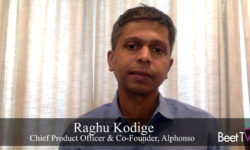Cord-cutting is still happening at a rate of knots whilst, for many viewers, traditional appointment-to-view TV is a thing of the past.
Amid these shifting audience behaviors, it would be tempting for marketers to contemplate switching from one medium to another.
But emerging evidence suggests a tag-team approach can drive optimal results.
In this video interview with Beet.TV, Jack Bamberger, the chief commercial officer at Amobee, an ad-tech platform whose software helps placement of ads across over-the-top and linear TV, says both are important.
Best of both
“The acceleration of CTV has been significant, but even linear has grown as well,” Bamberger says.
“It’s a sizeable pie. If you think about the most recent eMarketer stats, in terms of the size of that marketplace, the last (ad spend) numbers were about $70, $80 billion for the linear side of the (TV ad) business and CTV was somewhere around $7, $8, $9 billion.
“What we do is help people understand how we can actually use data across all of that. It’s really about the ‘and’ versus an ‘or’.
“The ability to connect broadcast linear TV and CTV and social and digital with extraordinarily rich data and business intelligence… that’s exactly what the industry is hungry for now.”
New commercial chief
Amobee is a media management software provider helping in the use of data for planning, transacting, measuring and analyzing ads across TV, digital and social.
Amobee, whose TV initiatives took off thanks to its earlier acquisition of Videology Group, helps advertisers buy and sell across 30-second connected TV and other video inventory.
Bamberger joined Amobee in April after serving as Verizon Media’s VP of global partnerships, bringing relationships with global agencies and other accounts following earlier stints at MEC, Dentsu, Meredith, Time Warner and IPG.
What's the point of advertising in markets where your products aren't on the shelf? Learn how to end ad waste by equipping your brand with smart SKU-level tactics: https://t.co/6nrIBqv1fn
— Amobee (@amobee) June 2, 2020
The road ahead
EMarketer now expects US TV ad spending revenue will have taken a dive during the first half of the year, thanks partly to COVID-19, leaving a bigger shortfall to make up through the year if it is not to fall below its typical $70 billion threshold.
All of which means the emergence of connected TV ad opportunities and even data-driven linear may have an important role to play – bringing higher effectiveness that could turn TV into a more performance-driven medium, encouraging agencies to return to spending.
Bamberger says advertisers want to know where viewers are shopping, how to deliver ads to them there based on in-store inventory and how to optimize upfront-bought media.
“In this time, there’s a desire for more flexibility, leveraging the right technology solution that’s enhanced by data-driven optimization,” he says.














































